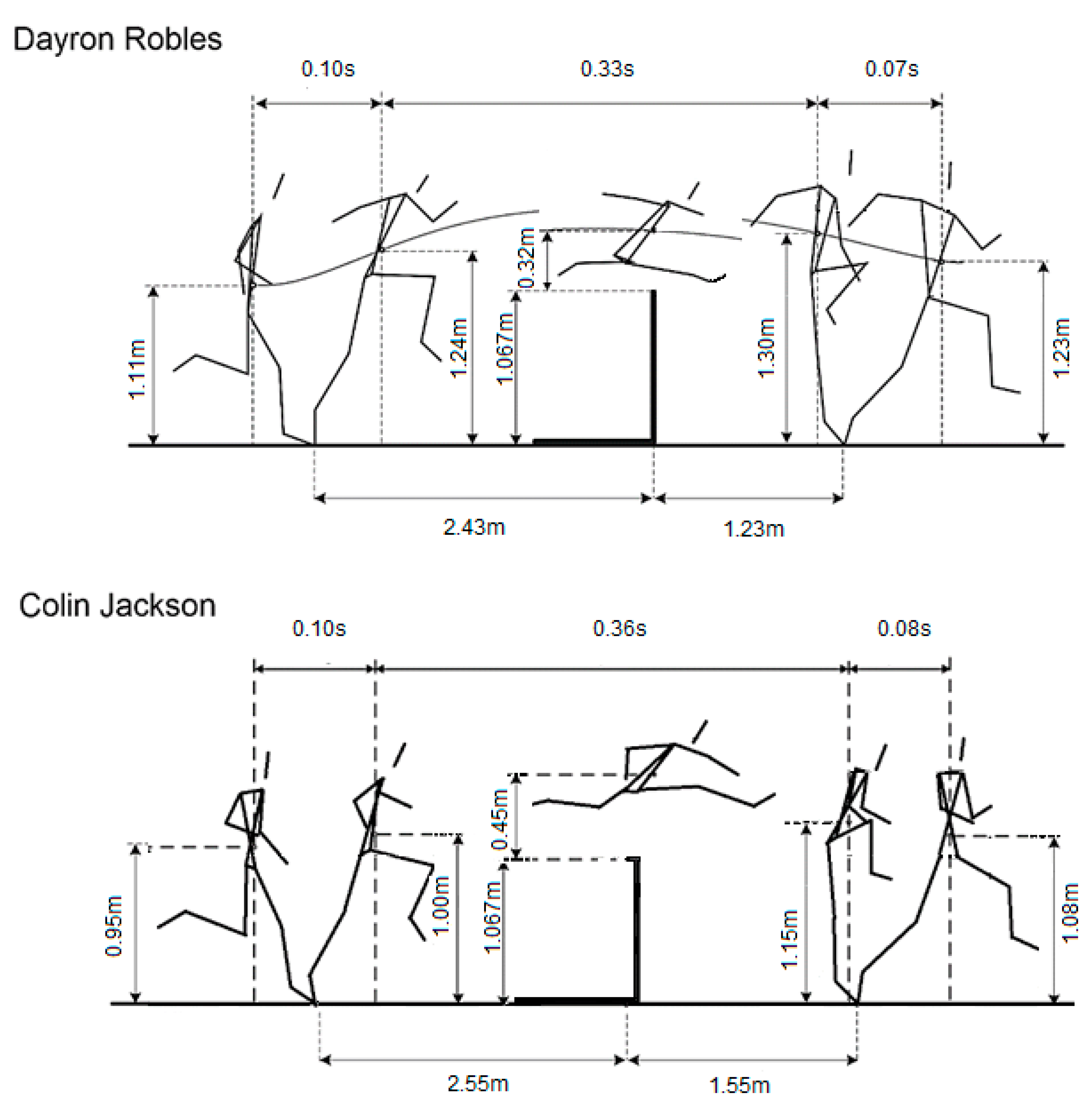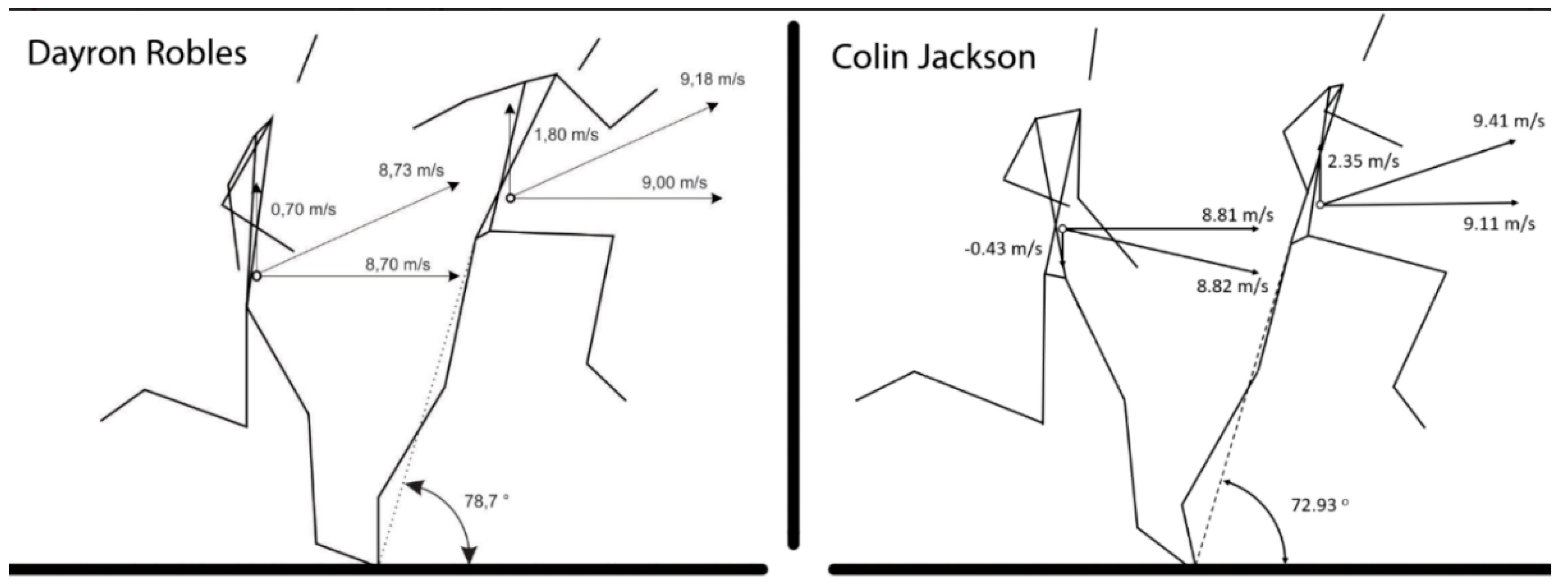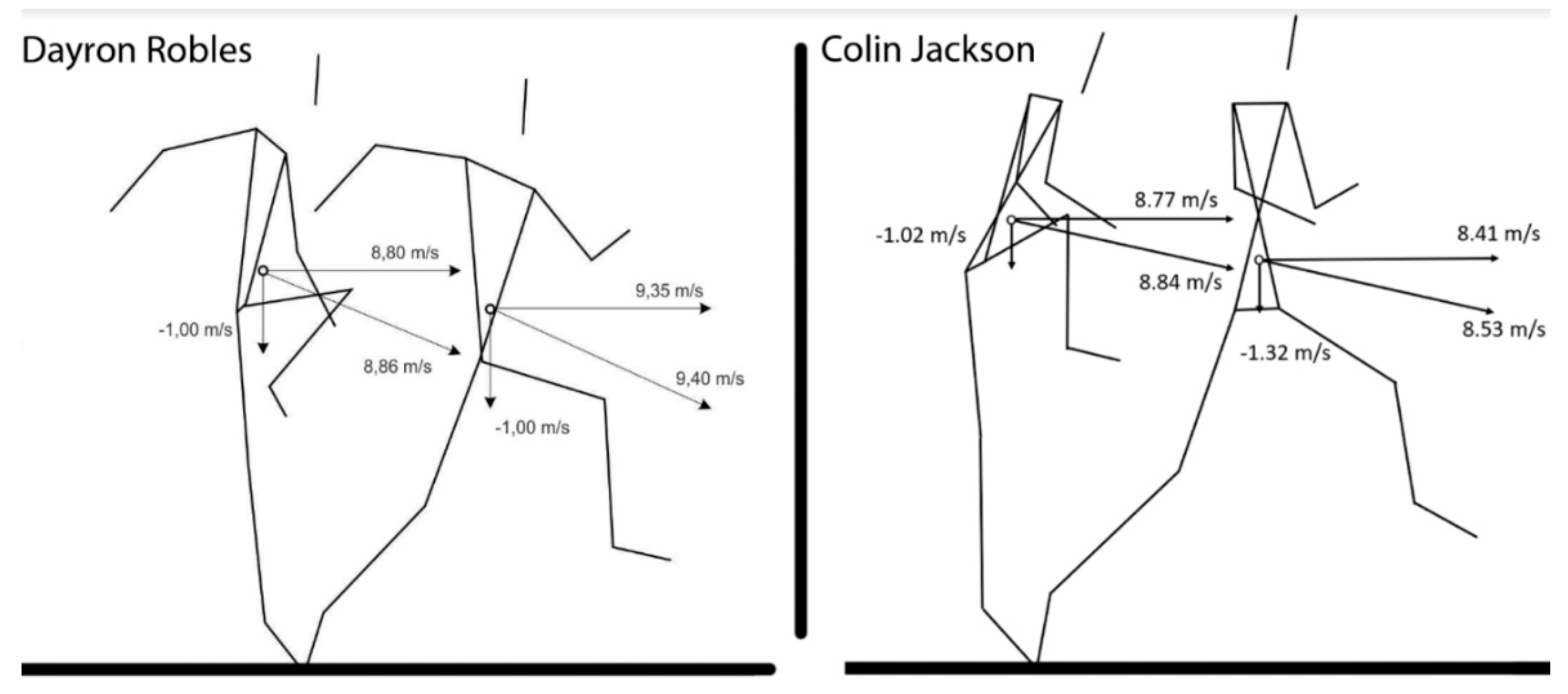Comparative Biomechanical Analysis of the Hurdle Clearance Technique of Colin Jackson and Dayron Robles: Key Studies
Abstract
1. Introduction
2. Materials and Methods
2.1. Participants
2.2. Experimental Design
2.3. Procedure of Measurements—Colin Jackson
2.4. Procedure of Measurements—Dayron Robles
3. Results
4. Discussion
5. Conclusions
6. Practical Application
Author Contributions
Funding
Acknowledgments
Conflicts of Interest
References
- Brüggemann, G.P.; Koszewski, D.; Müller, H. Biomechanical Research Project; Athens 1997, Final report; Meyer & Meyer Sport: Oxford, UK, 1999; pp. 12–41. [Google Scholar]
- Bollschweiler, L. A biomechanical Analysis of Male and Female Intermediate Hurdles and Steeplechasers. Master’s Thesis, Brigham Young University, Brigham, MA, USA, 2008. [Google Scholar]
- Salo, A.I.; Scarborough, S. Athletics: Changes in technique within a sprint hurdle run. Sport Biomech. 2006, 5, 155–166. [Google Scholar] [CrossRef]
- Iskra, J. The most effective technical training for the 110 metres hurdles. New Stud. Athl. 1995, 10, 51–55. [Google Scholar]
- Schluter, W. Kinematic features of the 110-meter hurdle technique (Kinematische Merkmale der 110-m Hurdentechnik). Leistungssport 1981, 2, 118–127. [Google Scholar]
- Mero, A.; Luhtanen, P. Biomechanical examination of the hurdle race during the World Championships in Helsinki. (Biomechanische Untersuchung des Hurdenlaufs während der Weltmeisterschaften in Helsinki. Leistungssport 1986, 1, 42–43. (In German) [Google Scholar]
- La Fortune, M.A. Biomechanical analysis of 110 m hurdles. Track Field News 1988, 105, 3355–3365. [Google Scholar]
- McDonald, C.; Dapena, J. Linear kinematics of the men’s and woman’s hurdles races. Med Sci. Sports Exerc. 1991, 23, 1382–1402. [Google Scholar] [CrossRef]
- Dapena, J. Hurdle clearance technique. Track Field Quart Rev. 1991, 116, 710–712. [Google Scholar]
- Mclean, B. The biomechanics of hurdling: Force plate analysis to assess hurdling technique. New Stud. Athl. 1994, 4, 55–58. [Google Scholar]
- Kampmiller, T.; Slamka, M.; Vanderka, M. Comparative biomechanical analysis of 110 m hurdles of Igor Kovač and Peter Nedelicky. Kinesiol. Slov. 1991, 1–2, 26–30. [Google Scholar]
- Lee, J. The Kinematic analysis of the hurdling of men’s 110 m hurdle. Korean J. Sport Biomech. 2004, 14, 83–98. [Google Scholar] [CrossRef]
- Iskra, J.; Coh, M. A review of biomechanical studies in hurdle races. Kinesiol. Slov. 2006, 1, 84–102. [Google Scholar]
- Sidhu, A.; Singh, M. Kinematical analysis of hurdle clearance technique in 110 m hurdle race. Int. J. Behav. Soc. Mov. Sci. 2015, 4, 28–35. [Google Scholar]
- Amritpals, S.; Shamsher, S. Relationship among the Technique of Hurdle Clearance Over the DifferentHurdles in 110 m Race. Int. J. Sci. Res. 2015, 4, 1591–1594. [Google Scholar]
- Chin-Shan, H.; Chi-Yao, C.; Kuo-Chuan, L. The wearable devices application for evaluation of 110 meter high hurdle race. J. Hum. Sport Exerc. 2020, 151, 1–9. [Google Scholar]
- Amara, S.; Mkaouer, B.; Chaabene, H.; Negra, Y.; Hammoudi-Riahi, S.; Ben- Salah, F. Key kinetic and kinematic factors of 110-m hurdles performance. J. Phys. Educ. Sport. 2019, 19, 658–668. [Google Scholar]
- Coh, M.; Zvan, M.; Bubanj, S. XXIIth International Symposium on Biomechanics in Sports; Lamontagne, M., Gordon, D., Robertson, E., Sveistrup, H., Eds.; ISBS: Ottawa, ON, Canada, 2004; pp. 311–314. [Google Scholar]
- Salo, A.; Grimshaw, P. 3–D biomechanical analysis of sprint hurdles at different competitive level. Med. Sci. Sports Exerc. 1997, 29, 231–237. [Google Scholar] [CrossRef]
- Lee, J.; Park, Y.; Ryu, J.; Kim, J. The kinematic analysis of the third hurdling motion of the 110 m hurdles elite. Korean J. Sport Biomech. 2008, 18, 31–39. [Google Scholar]
- Bubaj, R.; Stankovic, R.; Rakovic, A.; Bubanj, S.; Petrovic, P.; Mladenovic, D. Comparative biomechanical analysis of hurdle clearance techniques on 110 m running with hurdles of elite and non-elite athletes. Serb. J. Sports Sci. 2008, 2, 37–44. [Google Scholar]
- Li, X.; Zhou, J.; Li, N.; Wang, J. Comparative biomechanics analysis of hurdle clearance techniques. Port. J. Sport Sci. 2011, 11, 307–309. [Google Scholar]
- Amara, S.; Mkaouer, B.; Chaabene, H.; Negra, Y.; Hammoudi-Riahi, S.; Ben- Salah, F. Kinetic and kinematic analysis of hurdle clearance of an African and a world champion athlete: A comparative study. S. Afr. J. Res. Sport PH 2017, 39, 1–12. [Google Scholar]
- López, J.; Padullés, J.M.; Olsson, H.J. Biomechanical analysis and functional assessment of D. Robles, world record holder and Olympic champion in 110 m hurdles. In Proceedings of the 29th International Conference on Biomechanics in Sports, Porto, Portugal, 20–23 June 2011; Vilas-Boas, J.P., Ed.; ISBS: Porto, Portugal, 2011; pp. 315–318. [Google Scholar]
- Park, Y.J.; Ryu, J.K.; Ryu, J.S.; Kim, T.S.; Hwang, W.S.; Park, S.K.; Yoon, S. Kinematic analysis of hurdle clearance technique for 110-m men’s hurdlers at IAAF World Championships, Daegue 2011. Korean J. Sport Biomech. 2011, 21, 529–540. [Google Scholar] [CrossRef]
- Tsiokanos, A.; Tsaopoulos, D.E.; Tsarouchas, E.; Giavroglou, A. Race pattern of Men’s 110-H hurdles: Time analysis of Olympic performance. Biol. Exerc. 2018, 14, 15–36. [Google Scholar] [CrossRef]
- Graubner, R.; Nixdorf, E. Biomechanical analysis of the sprint and hurdles events at the 2009 IAAF World Championships in Athletics. New Stud. Athl. 2011, 26, 19–53. [Google Scholar]
- Pollitt, L.; Walker, J.; Bissas, A.; Merlino, S. Biomechanical report for the IAAF world championships 2017: 110 m hurdles men’s in 2017. In IAAF World Championships Biomechanics Research Project; International Association of Athletics Federations: London, UK, 2018. [Google Scholar]
- Walker, J.; Pollitt, L.; Paradisis, G.P.; Bezodis, I.; Bissas, A.; Merlino, S. Biomechanical Report for the IAAF World Indoor Championships 2018: 60 Metres Hurdles Men; International Association of Athletics Federations: Birmingham, UK, 2019. [Google Scholar]
- Dempster, W.T. Space Requirements of the Seated Operator; USAF, WADC, Tech. Rep.; Wright-Patterson Air Force Base: Greene County, OH, USA; pp. 55–159.
- Coh, M.; Iskra, J. Biomechanical studies of 110 m hurdle clearance technique. Sport Sci. 2012, 5, 10–14. [Google Scholar]
- González-Frutos, P.; Veiga, S.; Mallo, J.; Navarro, E. Spatiotemporal Comparisons between Elite and High-Level 60 m Hurdlers. Front. Psychol. 2019, 10, 1–9. [Google Scholar] [CrossRef]
- Wen, C. The High-Grade Tutorial of Track and Field; People’s Sports Press: Beijing, China, 2003; pp. 386–389. [Google Scholar]
- Li, J.; Fu, D. The kinematic analysis on the transition technique between run and hurdle clearance of 110 m hurdles. In XVIIIth International Symposium on Biomechanics in Sports; Hong, Y., Johns, D.P., Sanders, R., Eds.; ISBS: Hong Kong, China, 2000; pp. 213–217. [Google Scholar]
- Gollhofer, A.; Kyrolainen, H. Neuromuscular control of the human leg extensor muscles in jump exercises under various stretch-load conditions. Int. J. Sports Med. 1991, 12, 34–40. [Google Scholar] [CrossRef]
- Lee, J. Kinematic analysis of hurdling of elite 110 m hurdlers. Korean J. Sport Biomech. 2009, 19, 761–770. [Google Scholar] [CrossRef]
- Shibayama, K.; Fujii, N.; Shimizu, Y.; Ae, M. Analysis of angular momentum in hurdling by world and Japanese elite sprint hurdlers. In XXXth International Symposium on Biomechanics in Sports; Bradshaw, E.J., Burnett, A., Hume, P.A., Eds.; ISBS: Melbourne, Australia, 2012; pp. 54–57. [Google Scholar]
- Coh, M. Biomechanical analysis of Colin Jackson’s hurdle clearance technique. New Stud. Athl. 2003, 18, 37–45. [Google Scholar]
- Sidhu, A.S. Three-dimensional kinematic analysis of hurdle clearance technique. Global J. Res. Anal. 2016, 4, 4–6. [Google Scholar]
- Liiu, Y. A Kinesiological Analysis of the Hurdling Techniques of China’s 110 m Hurdlers Liu Xiang and Shi Dongpeng. Master’s Thesis, Shanxi University, Shanxi, China, 2008. [Google Scholar]



| Parameters | Colin Jackson | Dayron Robles |
|---|---|---|
| Date of birth | 1967 | 1986 |
| Body height (cm) | 1.82 | 1.92 |
| Body mass (kg) | 75 | 79 |
| Body Mass Index (BMI) | 22.64 | 21.43 |
| Best result (s) Experimental result (s) | 12.91 * 13.47 | 12.87 ** 13.00 |
| 100 m best results (s) | 10.29 | 10.71 |
| Variables | Colin Jackson | Dayron Robles | Difference | Δ (%) |
|---|---|---|---|---|
| Horizontal velocity 4 H–5 H (m/s) | 9.14 | 9.18 | 0.04 | 0.43 |
| Take-off (braking phase) | ||||
| Horizontal velocity of COM (m/s | 8.81 | 8.70 | 0.11 | 1.25 |
| Vertical velocity of COM m/s | –0.43 | –0.70 | 0.37 | 62.79 |
| Velocity resultant of COM (m/s | 8.82 | 8.73 | 0.09 | 1.03 |
| Height of COM (m) | 0.95 | 1.11 | 0.16 | 16.84 |
| Foot to hurdle distance (m) | 2.09 | 2.43 | 0.34 | 16.26 |
| Take-off (propulsion phase) | ||||
| Horizontal velocity of COM (m/s) | 9.11 | 9.00 | 0.11 | 1.21 |
| Vertical velocity of COM (m/s) | 2.35 | 1.80 | 0.55 | 23.41 |
| Velocity resultant of COM (m/s) | 9.41 | 9.18 | 0.23 | 2.45 |
| Height of COM (m) | 1.08 | 1.24 | 0.16 | 14.81 |
| Push-off angle (°) | 72.9 | 78.7 | 5.80 | 7.95 |
| Contact time (s) | 0.10 | 0.10 | 0.0 | 0.0 |
| Flight | ||||
| Flight time (s) | 0.36 | 0.33 | 0.03 | 8.34 |
| Height of COM above the hurdle (m) | 0.45 | 0.32 | 0.13 | 28.89 |
| Maximal height COM (m) | 1.44 | 1.52 | 0.08 | 5.55 |
| Landing (braking phase) | ||||
| Horizontal velocity of COM m/s | 8.77 | 8.80 | 0.03 | 0.34 |
| Vertical velocity of COM (m/s) | –1.02 | –1.00 | –0.02 | 1.97 |
| Velocity resultant of COM (m/s) | 8.84 | 8.86 | 0.02 | 0.22 |
| Height of COM (m) | 1.15 | 1.30 | 0.15 | 13.04 |
| Foot to hurdle distance (m) | 1.58 | 1.23 | 0.35 | 22.16 |
| Landing (propulsion phase) | ||||
| Horizontal velocity of COM (m/s) | 8.41 | 9.35 | 1.06 | 11.17 |
| Vertical velocity of COM (m/s) | –1.32 | –1.00 | –0.32 | 24.25 |
| Velocity resultant of COM (m/s) | 8.53 | 9.40 | 1.13 | 10.19 |
| Height of COM (m) | 1.06 | 1.23 | 0.17 | 16.03 |
| Contact time (s) | 0.08 | 0.07 | 0.01 | 12.50 |
© 2020 by the authors. Licensee MDPI, Basel, Switzerland. This article is an open access article distributed under the terms and conditions of the Creative Commons Attribution (CC BY) license (http://creativecommons.org/licenses/by/4.0/).
Share and Cite
Čoh, M.; Bončina, N.; Štuhec, S.; Mackala, K. Comparative Biomechanical Analysis of the Hurdle Clearance Technique of Colin Jackson and Dayron Robles: Key Studies. Appl. Sci. 2020, 10, 3302. https://doi.org/10.3390/app10093302
Čoh M, Bončina N, Štuhec S, Mackala K. Comparative Biomechanical Analysis of the Hurdle Clearance Technique of Colin Jackson and Dayron Robles: Key Studies. Applied Sciences. 2020; 10(9):3302. https://doi.org/10.3390/app10093302
Chicago/Turabian StyleČoh, Milan, Nejc Bončina, Stanko Štuhec, and Krzysztof Mackala. 2020. "Comparative Biomechanical Analysis of the Hurdle Clearance Technique of Colin Jackson and Dayron Robles: Key Studies" Applied Sciences 10, no. 9: 3302. https://doi.org/10.3390/app10093302
APA StyleČoh, M., Bončina, N., Štuhec, S., & Mackala, K. (2020). Comparative Biomechanical Analysis of the Hurdle Clearance Technique of Colin Jackson and Dayron Robles: Key Studies. Applied Sciences, 10(9), 3302. https://doi.org/10.3390/app10093302







